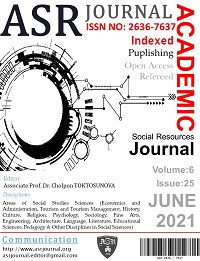Author :
Abstract
The study examined the impact of manufactured export on gross domestic product in Nigeria. The study selected 50 years period from 1970 to 2019. The study used ex-post facto research design. The population of this study is one the sector of the economy and sample size is one sector of non-oil export. The study used descriptive statistics, correlation analysis, unit root test and regression analysis with t-test and f-test. Data collected from Central Bank of Nigeria statistical bulletin were analysed using e-view version 9.00. The study found that there is positive and significant impact of manufacturing export on economic growth in Nigeria. The study recommended that Government of Nigeria should concentrate on manufacturing export since it lead to economic growth in terms of GDP.
Keywords
Abstract
The study examined the impact of manufactured export on gross domestic product in Nigeria. The study selected 50 years period from 1970 to 2019. The study used ex-post facto research design. The population of this study is one the sector of the economy and sample size is one sector of non-oil export. The study used descriptive statistics, correlation analysis, unit root test and regression analysis with t-test and f-test. Data collected from Central Bank of Nigeria statistical bulletin were analysed using e-view version 9.00. The study found that there is positive and significant impact of manufacturing export on economic growth in Nigeria. The study recommended that Government of Nigeria should concentrate on manufacturing export since it lead to economic growth in terms of GDP.
Keywords
- Ajie, C. O., Okoh, S. A. & Ojiya, E. A.(2019). The Impact Of Solid Minerals Resources On Economic
- Ajie, C. O., Okoh, S. A. & Ojiya, E. A.(2019). The Impact Of Solid Minerals Resources On EconomicGrowth In Nigeria: An Ols And Causality Approach. International Journal of Humanities, Art and Social Studies, 4(1)
- Letlhogonolo, M M. & Hinaunye, E. J. (2016). Manufactured Exports and Economic Growth in Swaziland:
- Torayeh, M.N., (2011). “Manufactured exports and economic growth in Egypt: Cointegration and causality analysis”. Applied Econometrics and International Development. 11 (1), 111-135.
- Kahyarara, G. (2013).Tanzania Manufacturing Exports and Growth:A Cointegration Approach, International Journal of Economics and ManagementSciences, 2(12):41-51.
- Sinoha-Lopote, R. (2004). Export Led Growth in Southern Africa, Unpublished Mater of Science Thesis Lousiana: B.S Louisiania State University.
- Jordaan A. C.& Eita J. H. (2009). Testing the Export-Led Growth Hypothesis for Botswana: A Causality Analysis, Botswana Journal of Economics,6(10):2-14.
- Yaghmaian, B. (1994)."An Empirical Investigation of Exports, Development,and Growth in Developing Countries: Challenging the Neoclassical Theory ofExport-Led Growth, World Development, vol. 22.
- Abu-Bader, S. (2001). "Financial development and economic growth: The Egyptian experience," Journal of Policy Modeling, Elsevier, vol. 30(5), pages 887-898.
- Okoh, R. N. (2004) Global Integration and the Growth of Nigeria’s Non-oil Exports. A paper presented atthe Centre for the Study of African Economies, African Conference 2004, on Growth, Poverty Reduction and Human Development in Africa, 21st to 22nd March 2004, Oxford, UK. Pp. 1-30
- Penny, S., Pritzker, P.O/. Ken, I. L. & Brian, L. (2015). ‘An evaluation of the trade relationships betweenSouth Africa and China: An empirical review 1995–2014’, South African Journal of Economic and Management Sciences 21(1)
- Pritzker, O.P. Arnold, I. U. & Moyer, M. K.(2015). Effect of Kenya’s Bilateral Relations with China on Economic Growth of Kenya (2000-2015). Journal of Economics and Finance, 9(5) 13-21
- Ikpeazu, C. (2000). "Tackling the Problems of Manufacturing Sector of the Nigeria Economy/Article of the Nigerian Industry Policy.
- Arnold, J., and K. Hussinger (2004). Export Behavior and Firm Productivity in German Manufacturing: A Firm-Level Analysis. Bocconi University and Centre for European Economic Research mimeo.
- Ahmed, A.T.A, Mandal, S, Chowdhury, D.A, Tareq, A.R.M., & Rahman, M.M. (1999). Bioaccumulation ofsome heavy metals in Ayre Fish (Sperata Aor Hamilton, 1822), sediment and water of Dhaleshwari River in dry season. Bangladesh J. Zool. 40(1):147-153.
- Ahmed, I. O. (2013). Aluminium production in Nigeria. International Journal of Business, 2(3) 33-41Wisdom, (2017). Types of manufacturing goods. International journal of industrial goods, 2(3) 21-33 Wikipedia, (2019). Manufacturing goods in Nigeria. online source
- United Nations COMTRADE database on international trade (2017). Data source information
- Teboho, R,, Mmamontsho, O. & Joel. I. (2016). Effect of empirical relationship between manufacturedexports and economic growth in SADC. International Journal of Business Management and Business, 3(3)22-34
- Uzochukwu, I. (2019). Effect of Low growth of manufacturing exports in Sub-Saharan African economies. International Journal of Economic and Finance, 2(3) 22-34
- Lin, J.Y. & Ren. R. (2007). East Asian Miracle Debate Revisited” (in Chinese). Jingji Yanjiu (Economic Research Journal) 42(8): 4 – 12.
- McCombie, J.S.L. and Thirlwall, A.P. (1994) Economic Growth and the Balance of Payments Constraint, Basingstoke, Macmillan
- Thirlwall, A.P. (1987). Keynes and Economic Development. London : Macmillan
- McCombie, J.S.L. & Thirlwall, A.P. (1997) ‘The Dynamic Harrod Trade Multiplier and the Demand-Oriented Approach to Economic Growth : An Evaluation’, International Review of Applied Economics, 2(3)76-81
- McCombie, J.S.L.(1989) ‘Thirlwall’s Law and Balance of Payments Constrained Growth – A Comment on the Debate’, Applied Economics, May
- McCombie, J.S.L. (1985) ‘ Economic Growth, the Harrod Trade Multiplier and the Hicks Supoer- Multiplier’, Applied Economics, February
